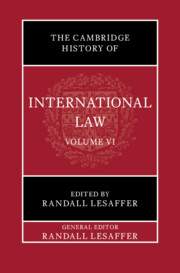Book contents
- The Cambridge History of International Law
- The Cambridge History of International Law
- Frontispiece
- The Cambridge History of International Law
- Copyright page
- Contents
- Plates
- Contributors
- Preface
- Abbreviations
- Part I International Law in Renaissance Europe (1492–1660)
- 1 The Law of Nations in Renaissance Europe
- 2 Territory and Jurisdiction in Renaissance Europe
- 3 Beyond the Free Sea
- 4 War and the Use of Force in Renaissance Europe
- 5 Warfare on Land in Renaissance Europe
- 6 The Law of Maritime Warfare during the Transition between Medieval and Early Modern Europe
- 7 Peacemaking in Renaissance Europe
- 8 Trade and Navigation in Renaissance Europe
- 9 Diplomacy in Renaissance Europe
- 10 Dispute Settlement in Renaissance Europe
- 11 The Ottoman Encounter and the Law of Nations in the Renaissance
- Part II International Law in Old Regime Europe (1660–1775)
- Index
- Plate Section (PDF Only)
- References
11 - The Ottoman Encounter and the Law of Nations in the Renaissance
from Part I - International Law in Renaissance Europe (1492–1660)
Published online by Cambridge University Press: 22 April 2025
- The Cambridge History of International Law
- The Cambridge History of International Law
- Frontispiece
- The Cambridge History of International Law
- Copyright page
- Contents
- Plates
- Contributors
- Preface
- Abbreviations
- Part I International Law in Renaissance Europe (1492–1660)
- 1 The Law of Nations in Renaissance Europe
- 2 Territory and Jurisdiction in Renaissance Europe
- 3 Beyond the Free Sea
- 4 War and the Use of Force in Renaissance Europe
- 5 Warfare on Land in Renaissance Europe
- 6 The Law of Maritime Warfare during the Transition between Medieval and Early Modern Europe
- 7 Peacemaking in Renaissance Europe
- 8 Trade and Navigation in Renaissance Europe
- 9 Diplomacy in Renaissance Europe
- 10 Dispute Settlement in Renaissance Europe
- 11 The Ottoman Encounter and the Law of Nations in the Renaissance
- Part II International Law in Old Regime Europe (1660–1775)
- Index
- Plate Section (PDF Only)
- References
Summary
The Ottomans had a variety of ways of dealing with non-Muslim foreigners. In theory, Islamic law assumed a constant state of war between Muslim and non-Muslim rulers, but in practice, long-term peace arrangements were possible and even common. In terms of diplomacy, the Ottomans’ instruments and peacemaking procedures were similar to those of the West, the Turks likewise building on established customs and practices from the Byzantine period and beyond. The ahdnames were particularly important for international relations; originally unilateral documents, they evolved into more reciprocal instruments, only to become more unilateral again in the second half of the seventeenth century. In theory, peace with unbelievers should be temporary, but in practice, the duration of treaties concluded by the Ottomans reflected their assessment of the likelihood of hostilities resuming; in the case of countries that did not pose any military threat to the sultan’s domains, peace could even be concluded indefinitely. As long as both sides maintained the friendship between the two parties, there was no need to fear the Turks. The interconnected phenomena of slavery and privateering regularly put a strain on this friendship, as men, women and children on both sides were dragged off and sold as chattel. This loss of life and property sometimes led to international incidents, in which the Ottoman authorities made it clear that the basic Islamic parameters of peace could not be ignored with impunity.
Keywords
- Type
- Chapter
- Information
- The Cambridge History of International Law , pp. 357 - 378Publisher: Cambridge University PressPrint publication year: 2025

